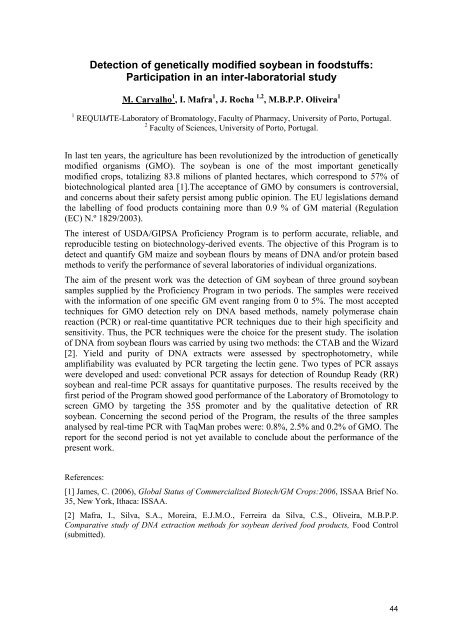IJUP08 - Universidade do Porto
IJUP08 - Universidade do Porto
IJUP08 - Universidade do Porto
- TAGS
- universidade
- porto
- ijup.up.pt
You also want an ePaper? Increase the reach of your titles
YUMPU automatically turns print PDFs into web optimized ePapers that Google loves.
Detection of genetically modified soybean in foodstuffs:<br />
Participation in an inter-laboratorial study<br />
M. Carvalho 1 , I. Mafra 1 , J. Rocha 1,2 , M.B.P.P. Oliveira 1<br />
1 REQUIMTE-Laboratory of Bromatology, Faculty of Pharmacy, University of <strong>Porto</strong>, Portugal.<br />
2 Faculty of Sciences, University of <strong>Porto</strong>, Portugal.<br />
In last ten years, the agriculture has been revolutionized by the introduction of genetically<br />
modified organisms (GMO). The soybean is one of the most important genetically<br />
modified crops, totalizing 83.8 milions of planted hectares, which correspond to 57% of<br />
biotechnological planted area [1].The acceptance of GMO by consumers is controversial,<br />
and concerns about their safety persist among public opinion. The EU legislations demand<br />
the labelling of food products containing more than 0.9 % of GM material (Regulation<br />
(EC) N.º 1829/2003).<br />
The interest of USDA/GIPSA Proficiency Program is to perform accurate, reliable, and<br />
reproducible testing on biotechnology-derived events. The objective of this Program is to<br />
detect and quantify GM maize and soybean flours by means of DNA and/or protein based<br />
methods to verify the performance of several laboratories of individual organizations.<br />
The aim of the present work was the detection of GM soybean of three ground soybean<br />
samples supplied by the Proficiency Program in two periods. The samples were received<br />
with the information of one specific GM event ranging from 0 to 5%. The most accepted<br />
techniques for GMO detection rely on DNA based methods, namely polymerase chain<br />
reaction (PCR) or real-time quantitative PCR techniques due to their high specificity and<br />
sensitivity. Thus, the PCR techniques were the choice for the present study. The isolation<br />
of DNA from soybean flours was carried by using two methods: the CTAB and the Wizard<br />
[2]. Yield and purity of DNA extracts were assessed by spectrophotometry, while<br />
amplifiability was evaluated by PCR targeting the lectin gene. Two types of PCR assays<br />
were developed and used: convetional PCR assays for detection of Roundup Ready (RR)<br />
soybean and real-time PCR assays for quantitative purposes. The results received by the<br />
first period of the Program showed good performance of the Laboratory of Bromotology to<br />
screen GMO by targeting the 35S promoter and by the qualitative detection of RR<br />
soybean. Concerning the second period of the Program, the results of the three samples<br />
analysed by real-time PCR with TaqMan probes were: 0.8%, 2.5% and 0.2% of GMO. The<br />
report for the second period is not yet available to conclude about the performance of the<br />
present work.<br />
References:<br />
[1] James, C. (2006), Global Status of Commercialized Biotech/GM Crops:2006, ISSAA Brief No.<br />
35, New York, Ithaca: ISSAA.<br />
[2] Mafra, I., Silva, S.A., Moreira, E.J.M.O., Ferreira da Silva, C.S., Oliveira, M.B.P.P.<br />
Comparative study of DNA extraction methods for soybean derived food products, Food Control<br />
(submitted).<br />
44










